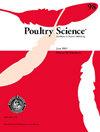Assessment of synergistic efficacy of carbaryl in combination with Cinnamomum cassia and Origanum vulgare essential oils against Dermanyssus gallinae
IF 3.8
1区 农林科学
Q1 AGRICULTURE, DAIRY & ANIMAL SCIENCE
引用次数: 0
Abstract
The poultry red mite Dermanyssus gallinae, a prevalent ectoparasite in egg-laying poultry, severely compromises bird health and impedes the poultry industry's development. However, the escalating drug resistance due to sustained reliance on chemical acaricides highlights the urgent need for new mite management strategies. Therefore, plant essential oils (EOs), which exhibit natural acaricidal properties and environmental compatibility, represent promising candidates for developing eco-friendly acaricides. In this study, we formulated binary mixtures of the median lethal concentrations (LC50) of carbaryl and EOs of Cinnamomum cassia and Origanum vulgare at ratios from 1:9 to 9:1 and then evaluated their contact toxicity, fumigant toxicity, and ovicidal effects against D. gallinae. The binary mixtures of C. cassia–carbaryl (2:8), O. vulgare–carbaryl (6:4), and C. cassia–O. vulgare (7:3) exhibited the most effective contact toxicity and achieved mite mortality rates of 60 %, 66.7 %, and 65.5 %, respectively, with poison ratios of 1.22, 1.25, and 1.24, respectively, indicating synergism. In the fumigant trials, the O. vulgare–carbaryl (6:4) mixture achieved 97 % mite mortality at 48 h, whereas the C. cassia–carbaryl (2:8) mixture demonstrated low mite mortality of 18 %. Notably, the C. cassia–O. vulgare mixture at 7:3 resulted in 87 % mite mortality, which was lower than that of the other ratios for this mixture. Furthermore, the ovicidal effects of the optimal binary mixtures of C. cassia–carbaryl (2:8), O. vulgare–carbaryl (6:4), and C. cassia–O. vulgare (7:3) were significantly better than those of a single drug, with egg hatchabilities of 2.3 %, 6.6 %, and 4.3 %, respectively, thus indicating strong inhibition of D. gallinae eggs. These combinations outperformed the single-agent controls, with egg hatchability rates of 31 % for C. cassia EO, 33.3 % for O. vulgare EO, and 20 % for carbaryl. Compared with the control group, mite eggs treated with the optimal binary mixtures and single drugs exhibited significant shrinkage and structural damage, which are consistent with low egg hatchability. These results demonstrate that integrating EOs with carbaryl could represent a viable alternative strategy for the management of poultry red mites.
评估西维因与肉桂和牛至精油对五倍子白蛾的协同增效作用。
家禽红螨 Dermanyssus gallinae 是产蛋家禽中普遍存在的一种体外寄生虫,严重危害家禽健康,阻碍家禽业的发展。然而,由于持续依赖化学杀螨剂,抗药性不断升级,因此迫切需要新的螨虫管理策略。因此,具有天然杀螨特性和环境兼容性的植物精油(EOs)有望成为开发生态友好型杀螨剂的候选物质。在本研究中,我们将西维因的中位致死浓度(LC50)与肉桂和牛至的 EO 按 1:9 至 9:1 的比例配制成二元混合物,然后评估了它们对五倍子的接触毒性、熏蒸毒性和杀卵效果。决明子-卡巴威(2:8)、O. vulgare-卡巴威(6:4)和决明子-O. vulgare(7:3)的二元混合物表现出最有效的接触毒性,螨虫死亡率分别为 60%、66.7% 和 65.5%,毒害比分别为 1.22、1.25 和 1.24,显示出协同作用。在熏蒸剂试验中,O. vulgare-卡巴威(6:4)混合物在 48 小时内的螨虫死亡率为 97%,而 C. cassia-卡巴威(2:8)混合物的螨虫死亡率较低,仅为 18%。值得注意的是,决明子-草甘膦混合物 7:3 的比例可导致 87 % 的螨虫死亡,低于该混合物的其他比例。此外,决明子-卡巴威(2:8)、O. vulgare-卡巴威(6:4)和决明子-O. vulgare(7:3)最佳二元混合物的杀卵效果明显优于单一药物,卵孵化率分别为 2.3 %、6.6 % 和 4.3 %,从而表明对五倍子螨卵有很强的抑制作用。这些组合药剂的效果优于单一药剂对照组,决明子环氧乙烷的卵孵化率为 31%,大黄环氧乙烷的卵孵化率为 33.3%,西维因的卵孵化率为 20%。与对照组相比,使用最佳二元混合物和单一药物处理的螨卵表现出明显的收缩和结构损伤,这与卵孵化率低是一致的。这些结果表明,将环氧乙烷与西维因结合使用可能是管理家禽红螨的一种可行的替代策略。
本文章由计算机程序翻译,如有差异,请以英文原文为准。
求助全文
约1分钟内获得全文
求助全文
来源期刊

Poultry Science
农林科学-奶制品与动物科学
CiteScore
7.60
自引率
15.90%
发文量
0
审稿时长
94 days
期刊介绍:
First self-published in 1921, Poultry Science is an internationally renowned monthly journal, known as the authoritative source for a broad range of poultry information and high-caliber research. The journal plays a pivotal role in the dissemination of preeminent poultry-related knowledge across all disciplines. As of January 2020, Poultry Science will become an Open Access journal with no subscription charges, meaning authors who publish here can make their research immediately, permanently, and freely accessible worldwide while retaining copyright to their work. Papers submitted for publication after October 1, 2019 will be published as Open Access papers.
An international journal, Poultry Science publishes original papers, research notes, symposium papers, and reviews of basic science as applied to poultry. This authoritative source of poultry information is consistently ranked by ISI Impact Factor as one of the top 10 agriculture, dairy and animal science journals to deliver high-caliber research. Currently it is the highest-ranked (by Impact Factor and Eigenfactor) journal dedicated to publishing poultry research. Subject areas include breeding, genetics, education, production, management, environment, health, behavior, welfare, immunology, molecular biology, metabolism, nutrition, physiology, reproduction, processing, and products.
 求助内容:
求助内容: 应助结果提醒方式:
应助结果提醒方式:


